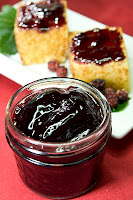 |
| Roma food mill |
Jam and jellies are differentiated by the clarity of the product based on the amount of pulp used. Jam is usually cloudy and thick, filled with pulp and fruit skins for texture. Jelly tends to be clear, or colored but still translucent. Both can be used on sandwiches, stirred into breakfast oatmeal, as a layer in a yogurt parfait, or as a component in a dessert.
 |
| Wineberry jam |
 |
| Wild blueberry jam on scones |
 |
| Mulberry jam |
 |
| Autumn olive jelly, not totally clear, but not pulpy |
 |
| Commercial onion jam, wild ramps jam |
 |
| Beautiful violet jelly |
 |
| Delicate black locust jelly |
 |
| Dandelion jelly |
 |
| Japanese knotweed jelly |



2 comments:
I tried making dandelion jelly this past spring and the infusion turned brown, rather than the sunny yellow color. I ended up not using it - did I take too long separating the yellow fluff from the green part of the flower or should I have added lemon juice to the infusion? Both? Looking forward to the spring again already. I know my grandmother used to make this (and dandelion wine), but I was too little at the time to remember ever having had it.
Adding lemon juice will change the pH level of the jelly, making it more acidic and acts as a preservative as well. It will dramatically help with the color retention. Good luck trying again, I know separating the yellow bits is very time consuming.
Post a Comment